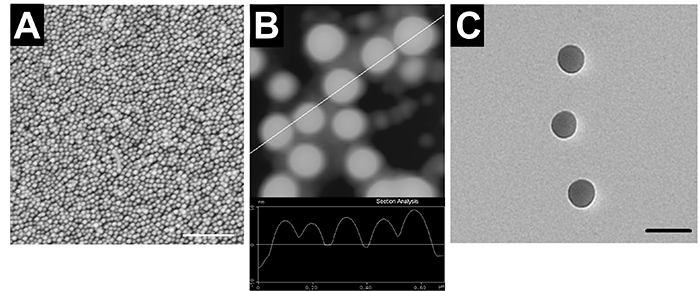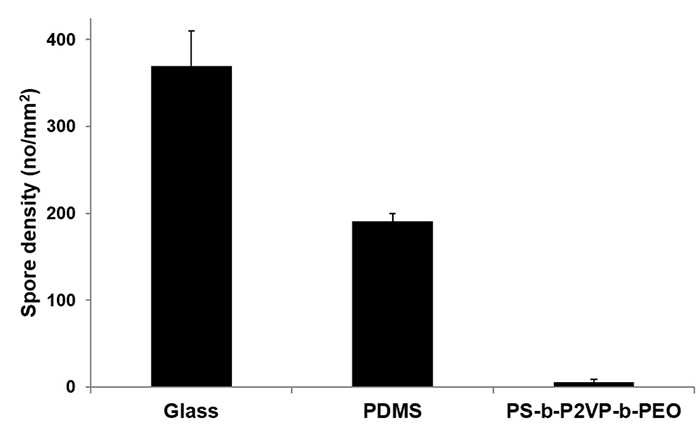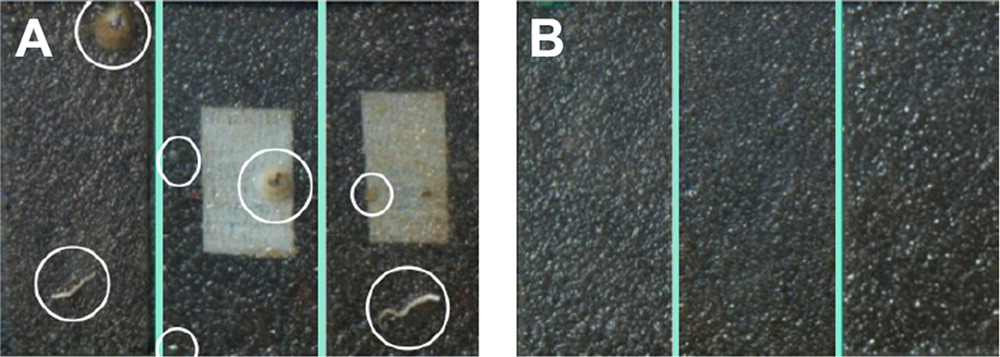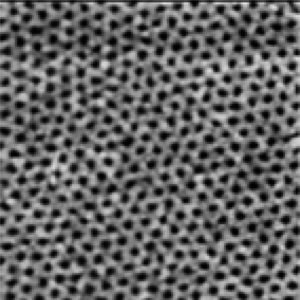Biofouling Control
Biofouling is the undesired accumulation of biomaterial on a surface. This occurs on many length and time scales. In the case of nanomaterials used for biodiagnostics, biofouling can involve proteins adsorbing onto nanoparticles or sensor surfaces, which hinders their function. This can be closely related to the nonspecific binding of nanoparticles to non-targeted regions of cells, as well. For this reason, we have been exploring the use of zwitterionic lipid coatings on nanoparticles that target cell surface receptors.
Surfaces that are in external environments, for example marine surfaces, develop not just protein deposition but also cellular and macrocellular fouling deposits. We have been exploring the application of amphiphilicity on the nanoscale, to inhibit such fouling. Applications have included aquaculture nets and models of ship hulls.

(A) AFM height image of PS-b-P2VP-b-PEO dip-coated onto a piranha-cleaned Si/SiO2 surface. The scale bar represents 700 nm. (B) Height profile of PS-b-P2VP-b-PEO micelles. (C) TEM image of PS-b-P2VP-b-PEO micelles taken at 75 kV. The scale bar represents 100 nm.

Density of attached zoospores of U. linza on uncoated glass, poly(dimethylsiloxane), and nanopatterned PS-b-P2VP-b-PEO micelle coatings after 45 minute settlement. Each point is the mean from 90 counts on 3 replicate slides. Bars show 95% confidence limits.

Comparison of settlement of macrofouling organisms (barnacles and tubeworms, indicated by white circles) on (A) poly(dimethylsiloxane)-coated glass and (B) PS-b-P2VP-b-PEO-coated glass after one month of static immersion. In (A), double-sided tape has been applied to safely transport glass panels between the field and lab.

Topography of cross-linked PS-b-P2VP film after eight days in water, exhibiting cylindrical domains. This exemplifies a nanopatterning approach toward min-imizing biofouling. Height range: 40 nm.
Representative publications
Kim, K. S.; Gunari, N.; MacNeil, D.; Finlay, J.; Callow, M.; Callow, J.; Walker, G. C. Aqueous-Based Fabrication of Low-VOC Nanostructured Block Copolymer Films as Potential Marine Antifouling Coatings. ACS Appl. Mater. Interfaces 2016, 8, 20342–20351. doi: 10.1021/acsami.6b04629.
Grozea, C. M.; Walker, G. C. Approaches in designing non-toxic polymer surfaces to deter marine biofouling. Soft Matter 2009, 5, 4088–4100. doi: 10.1039/B910899H.
Grozea, C. M.; Gunari, N.; Finlay, J. A.; Grozea, D.; Callow, M. E.; Callow, J. A.; Lu, Z.-H.; Walker, G. C. Water-Stable Diblock Polystyrene-block-poly(2-vinyl pyridine) and Diblock Polystyrene-block-Poly(methyl methacrylate) Cylindrical Patterned Surfaces Inhibit Settlement of Zoospores of the Green Alga Ulva. Biomacromolecules 2009, 10, 1004–1012. doi: 10.1021/bm900065b.
Patents
Gunari, N. A.; Walker, G. C. Aqueous based process to fabricate nanostructured block copolymer films. U.S. Patent US9221994B2, December 29, 2015. Canadian Patent CA2796080C, May 22, 2018.
